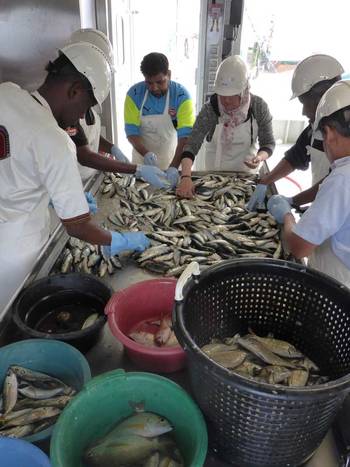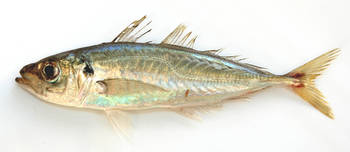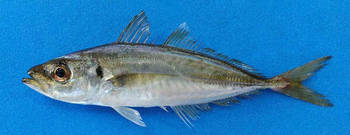Our taxonomist talks fish from aboard the Nansen
This very first survey voyage of the new Nansen, launched on its first survey voyage from Casablanca, Morocco this past May, is studying pelagic fish along the coast of northwestern Africa.
FAO’s own taxonomist, Peter Psomadakis, is on board the Nansen for this leg of the voyage, and he contributed this blog post to provide us more background about pelagic fish – the type of fish our scientists are studying – and other areas of scientific research on this survey voyage.
The Nansen serves not only as a floating laboratory, but also as a floating classroom, as subject specialists share their knowledge with those whose expertise is in another area. This rich exchange of ideas and knowledge amongst the scientists on board has always been cited as one of the most rewarding aspects of these Nansen journeys.
Since many of us are travelling along with these scientists as ‘armchair tourists’ – and reading the Nansen blog, it’s only fair that we learn alongside our colleagues.
Introducing you to pelagic fish
The term “pelagic” is used to define fishes that live in the illuminated, open waters, constantly away from the ocean bottom.
Technically pelagic fishes occur in the upper 200 m of coastal and open-sea areas. This region is unquestionably the most productive region of the sea as far as human consumption is concerned.
Coastal pelagic fishes such as anchovies, sardines, sardinellas make up about one-third of the total captured fish worldwide and offshore pelagic fishes such as tunas and billfishes make up an additional 15%.
The pelagic region is characterized by high solar illumination, variable production (it can be very high where upwelling occurs), large volumes and lack of physical structure. Many common threads run through the anatomy and biology of pelagic fishes.
They are schooling, countershaded (dark on the back, lighter on the sides and white underneath), round or slightly compressed and streamlined, with forked tails and have efficient respiration and food conversion capabilities. These features reflect adaptations to life in open water and continual swimming, often associated with long-distance migrations. Let’s now take a closer look at the pelagic species target of our survey.
he European anchovy Engraulis encrasicolus (family Engraulidae) occurs throughout the eastern Atlantic, northward to Norway, including the Mediterranean and Black Sea. It reaches a maximum length of 20 cm (commonly to 12-15 cm) and it is found mainly in shallow water (to 50 m), often forming large schools. Feeds on planktonic organisms, chiefly copepods, mollusc larvae, fish eggs and larvae. Spawning occurs multiple times over an extended period from April to November with peaks usually in the warmer months. Lifespan of individuals is short, 2 years at most.
In West Africa, three stocks are recognized, of which the western is largest with annual catches varying from 82 220 to 48 415 tonnes (1990-2008). It is caught mainly with purse seines, lamparas (light fishing) and trawls and marketed fresh, frozen, processed, salted and dried, smoked and used as bait.
The European pilchard Sardina pilchardus (family Clupeidae) is a migratory fish forming large schools at shallow depths in coastal waters. It occurs in the eastern Atlantic and Mediterranean Sea. In the Eastern Atlantic ranges from Spain and Gibraltar southward along coastal West Africa to at least southern Senegal. It reaches a max size of 32 cm (commonly 20-25 cm). Normally a ‘cold water’ species decreasing in abundance in the southern parts of its range. Feeds mainly on zooplanktonic crustaceans and other larger zooplankton. Maximum age is about 14 years. Sexual maturity occurs at age 2 and 3. Of considerable economic importance to fisheries of Morocco and Mauritania, principally off southern Morocco and northern Sahara (of limited importance southwards). Caught with purse seines, lamparas, gillnet, beach seines and bottom trawls. Most of the catch is made within coastal seas, only a small amount is taken in deeper areas at 50-70 m. Marketed fresh, frozen or canned or for processing in fishmeal.
The round sardinella Sardinella aurita (family Clupeidae) occurs in the eastern and western Atlantic. On the African coast ranges throughout the area from Gibraltar southwards at least to the border between Angola and Namibia. Also in the Mediterranean, but rare in the Black Sea. It reaches a maximum length of 42 (commonly to 25 cm). Forms large dense schools in nearshore waters. Normally a ‘warm water’ species preferring warm coastal waters.
Feeds on zooplankton, especially copepods. Spawns at all times of the year off West Africa, with distinct seasonal peaks, which in some areas are linked with upwelling events. Lives to about 6 years. Of considerable commercial importance off West African coasts. Caught by canoe fishermen using ring nets, gillnets and beach seines; by local purse seiners and by industrial trawlers. Marketed fresh, frozen, also smoked, canned, salted and dried, and used in production of fishmeal.
The Madeiran sardinella Sardinella maderensis (family Clupeidae) occurs throughout the eastern Atlantic, from Spain and Gibraltar southward along coastal West Africa to at least the border between Angola and Namibia. Also in the southern parts of the Mediterranean Sea and penetrating the Suez Canal. It reaches a maximum length of 32 (commonly 20 to 25 cm). Schools at the surface or at the bottom down to at least 50 m. Normally a ‘warm water’ species more coastal and euryhaline (juveniles sometimes entering estuaries) with respect to S. aurita. Seasonal movements are linked to seasonal upwelling. Inshore/offshore movements correlate also with rainy and dry seasons. Feeds on a variety of small planktonic organisms, including phytoplankton and zooplankton, also fish larvae. Reaches sexual maturity during its third year of life. Of considerable commercial importance off West African coasts. Caught by canoe fishermen using ring nets, gillnets, very large cast nets and beach seines; by local purse seiners and by industrial trawlers. Marketed fresh, frozen, also smoked, canned, salted and dried, and used in production of fishmeal.
The Atlantic chub mackerel Scomber colias (family Scombridae) is a coastal schooling species found in temperate and subtropical waters of the western and eastern Atlantic Ocean, including the Mediterranean and Black seas. Reaches a maximum size of 50 cm (commonly to 30 cm) and feeds on small pelagic fishes, especially clupeoids and pelagic invertebrates. Seasonal migrations may be very extended. Caught with purse seines, often together with sardines, sometimes using light (also with trolling lines, gillnets, gillnets and midwater trawls). Marketed fresh, frozen, smoked, salted and occasionally also canned.
The Atlantic horse mackerel Trachurus trachurus (family Carangidae) is a schooling species commonly found over sandy bottoms at 20 to 120 m depth. Also pelagic and near the surface at times. In the eastern Atlantic occurs throughout the African coast from the Straits of Gibraltar to Senegal, including Madeira, Canary and Cape Verde Islands; northward extending into the Mediterranean Sea and the Atlantic coasts of Europe to Norway. It reaches a maximum size to about 60 cm (commonly to 30 cm) and feeds on a wide variety of pelagic and benthic fishes, crustaceans and squids. Caught with trawls
The Cunene horse mackerel Trachurus trecae (family Carangidae) is a schooling species usually occurring near the bottom at 20 to 200 m depth. Also pelagic and near the surface at times. It the eastern Atlantic is known from the Canary (very rare) and Cape Verde Islands and along the African coast from Morocco/Mauritania to southern Angola.
It reaches a maximum size of 35 cm and feeds primarily on crustaceans. Sexually mature fish make seasonal migrations along the coast largely related to water temperature. Caught with pelagic and bottom trawls and with purse seines; also with longlines. Utilized fresh, frozen, dried-salted, smoked and canned.
Let’s talk about plankton
The pelagic environment is not only inhabited by fish and other pelagic dwellers capable of swimming in directions independently of ocean currents (collectively known as nekton), but is also the home of small drifting organisms commonly known as plankton.
Plankton includes the phytoplankton, which are single-celled minute plant organisms living in the uppermost layers of the pelagic zone where they find sufficient light for photosynthesis, and the zooplankton (animal organisms) that largely feed on the abundant phytoplankton.
The zooplankton itself represents the principal source of food for the young of many fish species as well as for a variety of other animals such as for instance larger zooplankton, corals, seabirds, and marine mammals. Simply put, the phytoplanktonic organisms growing in the upper layers of the ocean provide the basis of all life in the entire pelagic zone!
The pelagic zone is home also of another guild of drifting animals, the neuston. Neustonic organisms such as cnidarians (e.g. Velella velella), siphonopheres (Physalia physalis) and gastropods (Janthina janthina), float on the surface of the water and are moved both by currents and wind.
Curiosities from the deck: Striking symbiosis
The relationship between hermit crabs and sea anemones is a well-known example of mutualistic symbiosis between two different marine organisms. The advantages of the relationship seems obvious in that the sea anemone gets a solid place to attach and a free ride to potential food, while the hermit crab gets protection from predators.
Less known is the relationship between the hermit crabs and the encrusting sponge Suberites domuncula. In such relationship, the gastropod shell occupied by the hermit crab represents the core around which the sponge grows. The end product is a subspherical potato-shaped structure occupied by the hermit crab. This very distinctive symbiotic relationship offers advantages to both partners and allows them to cope with local environmental constraints that govern a very complex ecosystem such as the one found off the northwest Mauritania coast.
Such kind of potato-shaped associations of sponges and hermit crabs were found in our bottom trawl catches (see accompanying photo).
Thank you, Peter, for this helpful fisheries lesson concentrated on the coast of northwestern and western Africa.
Readers, if you have any questions, remember that you can ask Peter or any of our scientists your questions by using the comment bars at the bottom of this post.
Until next time!












